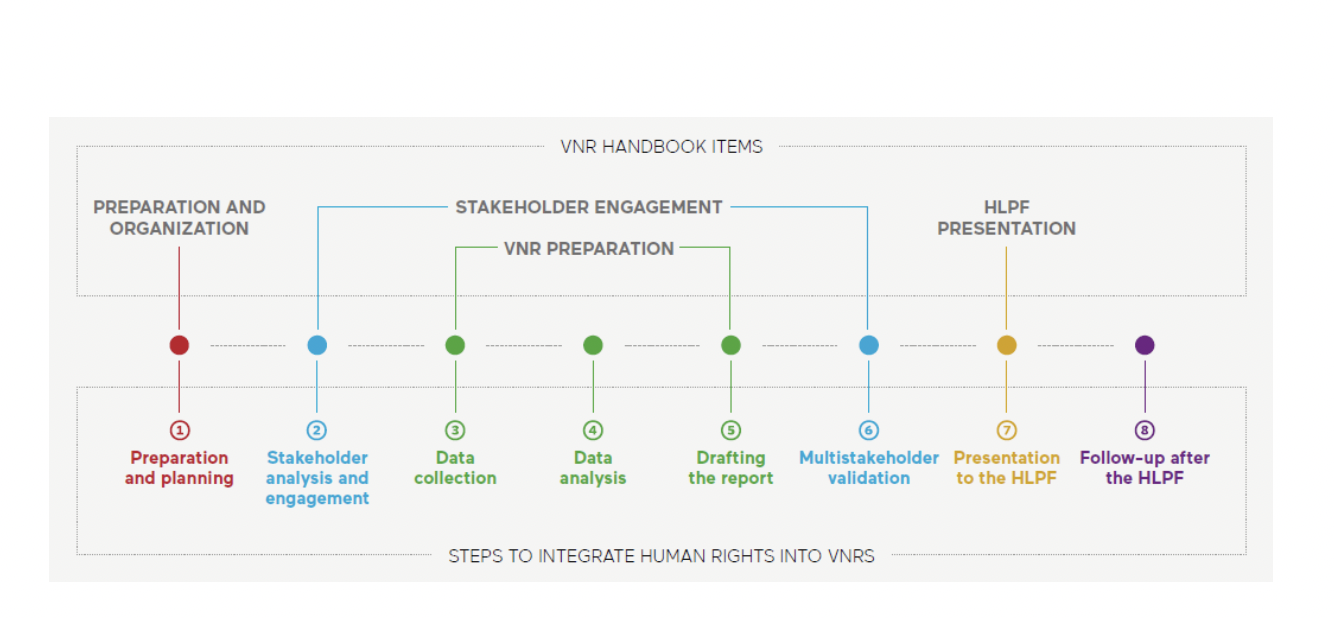The UN has launched a practical guidance on human rights and Voluntary National Reviews.
Developed under the Secretary-General’s Call to Action for Human Rights, the guidance aims to support governments and others in maximizing synergies between human rights and 2030 Agenda reporting processes.
The guidance demonstrates how human rights-based approaches and tools can strengthen VNRs and help accelerate SDG implementation.
At a time when, globally, the UN Secretary-General is warning about a “perfect storm” of crises and calling for urgent action to put out a “five-alarm global fire” while referring to the COVID-19 pandemic, a morally bankrupt global financial system, the climate crisis, lawlessness in cyberspace, and diminished peace and security, we need to first and foremost reaffirm our commitment to truly sustainable development. The solution? In the words of Michelle Bachelet, UN High Commissioner for Human Rights, “we need to invest in addressing the conditions that provoke these crises.” We need to invest in human rights.
Inȇs Gomes, working with the VoZ di Paz organization in the Tombali region in Guinea Bissau, shared a similar message at the consultations organized as part of the country’s Voluntary National Review (VNR) preparations. “All the Goals cannot be achieved in poverty. Lack of justice is also associated with poverty, so SDG 1 needs to be our biggest battle.”
Guinea Bissau organized consultations focusing on the central promise of the 2030 Agenda – to leave no one behind – in all nine regions of the country, supported by the UN Resident Coordinator’s Office in Guinea Bissau and OHCHR’s Surge Initiative. This is just one example of how countries are integrating human rights approaches in their VNR processes and which are highlighted in the new Human Rights and Voluntary National Reviews Operational Common Approach Guidance Note.

The guidance, developed under the Secretary-General’s Call to Action for Human Rights, aims to support governments and others in maximizing synergies between human rights and 2030 Agenda reporting processes. It presents a practical eight-step approach to support the development of VNRs in a way that integrates human rights throughout the process.

Human rights are central to the SDGs, the same should hold for VNRs
The guidance also demonstrates how human rights-based approaches and tools can strengthen VNRs and help accelerate SDG implementation. With a vast majority of the SDGs and targets mirroring international human rights or labor standards, the SDGs and human rights are mutually reinforcing. This means that no country will be able to deliver on the 2030 Agenda without also working towards fulfilling all human rights for all. The best and most efficient way to do this is to learn how to reap the benefits of complementarity between VNRs and the work of the international and regional human rights systems.
“The Secretary-General’s Call to Action for Human Rights challenges us to do better on human rights together. We hope this new guidance helps answer that call by showing, practically, how central human rights are to the 2030 Agenda follow-up and review. VNRs are key not only for tracking progress, but also for ensuring we truly leave no one behind. Human rights-based approaches provide the tools we need to safeguard sustainable development for everyone, without discrimination,” Ilze Brands Kehris, Assistant Secretary-General for Human Rights, said about the guidance.
Twinning human rights and development reporting for better results
The guidance also highlights Samoa as a good example in aligning VNR and human rights reporting processes. Samoa utilized the organization of the extraordinary 84th session of the Committee on the Rights of the Child (CRC), which it hosted in March 2020, to gather relevant information and consult with children. This information informed the Samoan second VNR report, which in turn fed into the country’s Universal Periodic Review (UPR) report presented the following year.
But the key goal of course is not merely improving reports. What we want and what we need in order to create the World We Want is to improve implementation, while ensuring that we are not leaving people, population groups, or countries behind.
2030 Agenda grounded in human rights is the blueprint for success
Human rights offer one of the strongest foundations for the 2030 Agenda. The Secretary-General’s Call to Action for Human Rights and Member State initiatives such as the Sustainable Recovery Pledge squarely place human rights at the core of sustainable development, and the VNRs should do so, too.
“When we address human rights challenges, we also make progress on fundamental development challenges. And so, with the SDGs and 2030 Agenda in the balance, we must move quickly to integrate human rights work into our toolbox for addressing contemporary development issues.” These words from Asako Okai, Assistant Secretary-General, Assistant Administrator and Director Crisis Bureau, UNDP, delivered during the organization’s Annual Rule of Law and Human Rights Meeting in June 2022, very much hold true for the guidance – a concrete offer from the UN system in supporting Member States to tackle development challenges through a human rights-based approach.
Development of the guidance note under the Call to Action for Human Rights was led by the UN Development Programme (UNDP) and Office of the United Nations High Commissioner for Human Rights (OHCHR), with contributions from across the UN System and support from the Human Rights Mainstreaming Fund. For further information, please reach out to UNDP at humanrights@undp.org and to OHCHR at ohchr-newyork@un.org. The guidance was launched at a VNR Lab convened on the margins of the High-level Political Forum on 7 July. This article was co-authored by OHCHR and UNDP.